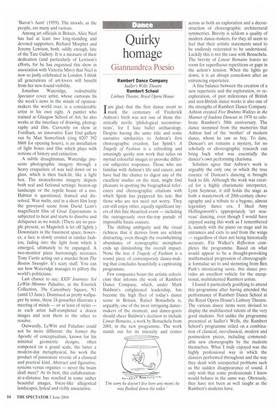Quirky homage
Giannandrea Poesio
Rambert Dance Company Sadler's Wells Theatre Rambert School Linbuty Theatre, Royal Opera House
Iamglad that the first dance event to mark the centenary of Frederick Ashton's birth was not one of those theatrically sterile 'philological reconstructions', for I hate ballet archaeology. Despite having the same title and some narrative similarities to Ashton's first choreographic creation, Ian Spink's A Tragedy of Fashion is a refreshing and amusingly quirky new work that relies on myriad colourful images to provoke different subjective responses. Those who are familiar with Ashton's life and career, and have had the chance to digest any of the excellent studies on the man, might find pleasure in spotting the biographical references and choreographic citations with which Spink has peppered his text. But those who are not need not worry. They can still enjoy other, equally significant layers of this tine theatrical event — including the outrageously over-the-top parade of impossible haute couture.
The shifting ambiguity and the visual richness that it derives from are seldom distracting, even though the overwhelming abundance of iconographic metaphors ends up diminishing the overall impact. None the less A Tragedy of Fashion is a sound piece of contemporary dance-making that concludes beautifully a captivating programme.
Few companies boast the artistic eclecticism that informs the work of Rambert Dance Company, which, under Mark Baldwin's enlightened leadership, has become the high flyer of today's dance scene in Britain. Rafael Bonachela is, arguably, one of the most intriguing dancemakers of the moment, and dance-goers should cheer Baldwin's decision to include Linear Remains, a work by Bonachela from 2001, in the new programme. The work stands out for its intensity and comes across as both an exploration and a deconstruction of choreographic architectural symmetries. Brevity is seldom a quality of modern dance-makers, for they all seem to feel that their artistic statements need to be endlessly reiterated to be understood. Luckily this is not the case with Bonachela. The brevity of Linear Remains leaves no room for superfluous repetitions or gaps in the action's tension. When the lights go down, it is an abrupt comedown after an entrancing experience.
A fine balance between the creation of a new repertoire and the exploration, or reexploration, of past milestones of British and non-British dance works is also one of the strengths of Rambert Dance Company. Ashton created Five Brahms Waltzes in the Manner of Isadora Duncan in 1976 to celebrate Rambett's 50th anniversary. The dance stemmed from the memories that Ashton had of the 'mother' of modern dance, whom he saw as boy. To date, Duncan's art remains a mystery, for no scholarly or choreographic research can bring back what was essentially the dancer's own performing charisma.
Scholars agree that Ashton's work is arguably the only one in which the true essence of Duncan's dancing is brought back to life. Although the work was created for a highly charismatic interpreter, Lynn Seymour, it still holds the stage as both a masterwork of 20th-century choreography and a tribute to a bygone, almost legendary dance era. I liked Amy Hollingsworth's appropriately 'art nouveau' dancing, even though I would have enjoyed seeing this work as I remembered it, namely with the piano on stage and its entrances and exits to and from the wings — regardless of their not being historically accurate. Fin Walker's Reflection completes the programme. Based on what would appear to be a thought-provoking mathematical progression of choreographic formulae set to and stemming from Ben Park's intoxicating score, this dance provides an excellent vehicle for the exceptional, multitalented Rambert artists.
found it particularly gratifying to attend this programme after having attended the performance of Rambert Dance School at the Royal Opera House's Linbury Theatre. The various dance items were devised to display the multifaceted talents of the very good students. Not unlike the programme presented at Sadler's Wells, the Rambert School's programme relied on a combination of classical, neo-classical, modern and postmodern pieces, including commendable new choreography by the students themselves. What I truly enjoyed was the highly professional way in which the dancers performed throughout and the way they dealt with unexpected problems such as the sudden disappearance of sound. I only wish that some professionals I know would behave in the same way. Obviously, they have not been as well taught as the Rarnbert's students have.










































































 Previous page
Previous page